Complete Solutions to EXERCISE of chapter LAWS OF MOTION of Class 11 book with complete answers and questions
| Class 11 | PHYSICS |
| Chapter | LAWS OF MOTION |
| NCERT | EXERCISE |
| Number Of Questions | 40 |
| Academic Year | 2023-24 |
Give the magnitude and direction of the net force acting on
(a) a drop of rain falling down with a constant speed
(b) a crok of mass 10 g floating on water
(c) a kite skilfully held stationary in the sky
(d) a car moving with a constant velocity of `30 kh//h` on a rough road
(e) a high speed electron in space free from all gravitational objects and free of electric and magnetic fields.02:21View SolutionA pebble of mass 0.05 kg is thrown vertically upwards Give the magnitude and direction of net force on the pebble (a) during its upward motion (b) during its downward motion (c) at the highest point where it is momentarily rest
Do your answers change if the pebble were thrown at an angle of say `45^(@)` horizontal direction lgnore air resistance .02:32View SolutionGive the magnitude and direction of the force acting on a stone of mass 0.1 kg (a) just after it is dropped from the window of a stationary train
(b) just after it is dropped from the window of a train running at a constant velocity of `36 km//hr`
(c) just after it is dropped from the window of a train accelerating with `1 ms^(-2)`
(d) lying on the floor of a train which is accelerating with `1 ms^(-2)` the stone being at rest relative to the train .
Neglect the resistance of air throughout .03:43View SolutionOne end of string of length `l` is connected to a particle on mass `m` and the other end is connected to a small peg on a smooth horizontal table. If the particle moves in circle with speed `v` the net force on the particle (directed toward centre) will be (`T` reprents the tension in the string):
02:22View SolutionA constant retarding force of 50 N is applied to a body of mass 20 kg moving initially with a speed of `15ms^(-1)` How long does the body take to stop ?
02:15View SolutionA constant force acting on a body of mass `3 kg` changes its speed from `2ms^(-1)` to `3.5 ms^(-1)` in 25 s. The direction of motion of the body remains unchanged. Calculate magnitude and direction of the force.
01:50View SolutionA body of mass 5 kg is acted upon by two perpendicular forces 8 N and 6 N Give the magnitude and direction of the acceleration of the body.
02:29View SolutionThe driver of a three wheeler moving with a speed of `36 km//h` sees a child standing in the middle of the road and brings his vehicle to rest in 4 s just in time to save the child What is the average retarding force on the vehicle ? The mass of three wheeler is 400 kg and mass of the driver is 65 kg.
02:46View SolutionA rocket with a lift off mass 20000 kg is blasted upwards with a net initial acceleration of `5 ms^(-2)` Calculate the initial thrust (force) of the blast.
02:11View SolutionA body of mass 0.40 kg moving initially with a constant speed of `10 m//s` to the north is subjected to a constant force of 8.0 N directed towards the south for 30 s Take the instant the force is applied to be t = 0, and the position of the particle at that time to be x = 0, predict its position at `t = -5 s , 25 s, 100 s` ?
06:28View SolutionA truck starts from rest and accelerate uniformly with `2 ms^(-2)`. At t = 10 s a stone is dropped by a person standing on the top of the truck (6 m high from ground). What are the (a) velocity and (b) acceleration of the stone at t = 11 s ? Neglect air resistance.
03:42View SolutionA bob of mass 0.1 kg hung from the ceiling of a room by a string 2 m long is set into oscillation The speed of the bob at its mean position ` 1 m//s ` What is the trajectory of the bob if the string is cut when the bob is (a) at one of its extreme position (b) at is mean position ?
02:15View SolutionA man of mass 70 kg stands on a weighing machine in a lift, which is moving (a) upwards with a uniform speed of `10ms^(-1)`
(b) downwards with a uniform acceleration of `5 ms^(-2)`
(c) upwards with a uniform acceleration of `5 ms^(-2)` What would be the readings on the scale in each case ?
(d) What would be the reading if the lift mechanism failed and it hurtled down freely under gravity ?05:18View SolutionFig. shows the position-time graph of a particle of mass 4 kg. What is the (i) force acting on the particle for `t lt 0, t lt 4 s, 0 lt t lt 4 s`? (ii) impulse at t = 0 and t = 4 s? Assume that the motion is one dimensional.
 03:39View Solution
03:39View SolutionTwo bodies of masses 10 kg and 20 kg respectively kept on a smooth horizontal surface are tied to the ends of a light string A horizontal force F = 600 N is applied to (i) A and (ii) B along the direction of string. What is the tension in the string in each case ?
03:29View SolutionTwo masses 8 kg and 12 kg are connected at the two ends of a light in extensible string that passes over a friction less pulley. Find the acceleration of the masses and tension in the string , when the masses are released
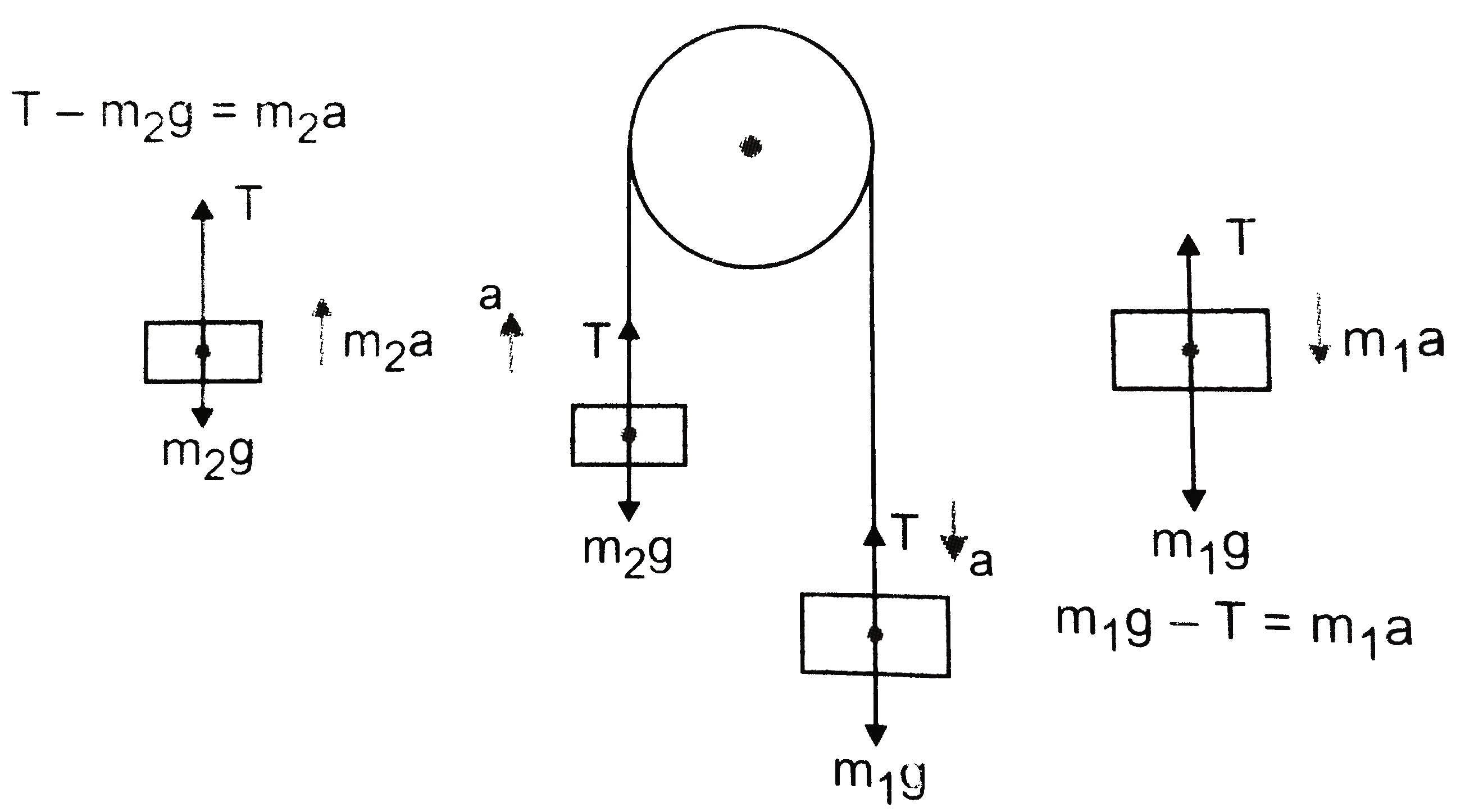 . 02:49View Solution
. 02:49View SolutionA nucleus is at rest in the laboratory frame of reference. Show that if it disintegrates into two smaller nuclei the products must be emitted in opposite directions.
02:01View SolutionTwo billiard balls each of mass 0.05 kg moving in opposite directions with speed `6 ms^(-1)` collide and rebound with the same speed. What is the impulse imparted to each ball due to the other ?
02:38View SolutionA shell of mass 200g is fired by a gun of mass 100kg. If the muzzle speed of the shell is `80ms^(-1)`, then the recoil speed of the gun is
04:39View SolutionA batsman deflects a ball by an angle of `45^(@)` without changing its initial speed which is equal to `54 km/h`. What is the impulse imparted to the ball ? (Mass of the ball is 0.15 kg)
12:24View SolutionA stone of of mass 0.25 kg tied to the end of a string is whirled round in a circle of radius 1.5 m with a speed of `40 rev//min` in a horizontal plane What is the tension in the string ? What is the maximum speed with which the stone can be whirled around If the string can withstand a maximum tension of 200 N ?
02:45View SolutionIf in Q . 21 the speed of the stone is increased beyond the maximum permissible value and the string breaks suddenly which of the following correctly describes the trajectory of the stone after the string breaks :
(a) the stone jerks radially outwards
(b) the stone flies off tangentially from the instant the string breaks
(c) the stone flies off at an angle with the tangent whose magnitude depends on the speed of the stone ?02:23View SolutionExplain why
(a) A horse cannot pull a cart and run in empty space.
(b) Passengers are thrown forward from their seats when a speeding bus stops suddenly.
(c ) A cricketer moves his hands backwards when holding a catch.03:25View SolutionFigure shows the position-time graph of a particle of mass `0.04kg`. Suggest a suitable physical context for this motion. What is the time between two consecutive impulses received by the particle? What is the magnitude of each impulse?
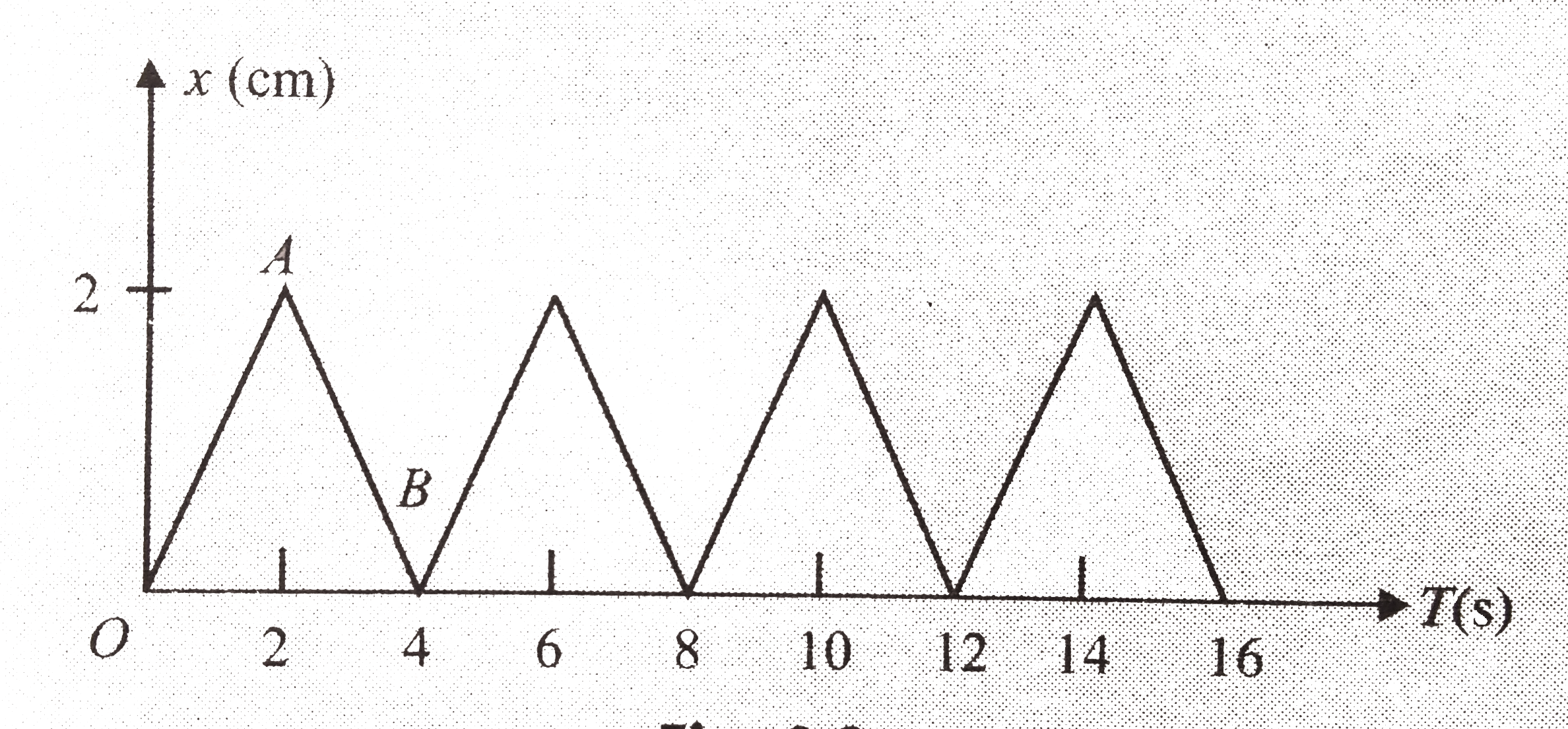 03:28View Solution
03:28View SolutionFigure shown a man standing stationary with respect to a horizontal converyor belt that is accelerationg with `1m//s^(-2)` . What is the net force on the man?If the coefficient of ststic friction between the man's shoes and the belt is `0.2` upto what maximum acceleration of the belt can the man continue to be stationary relative to the belt? Mass of the man`= 65kg (g =9.8m//s^(2))`
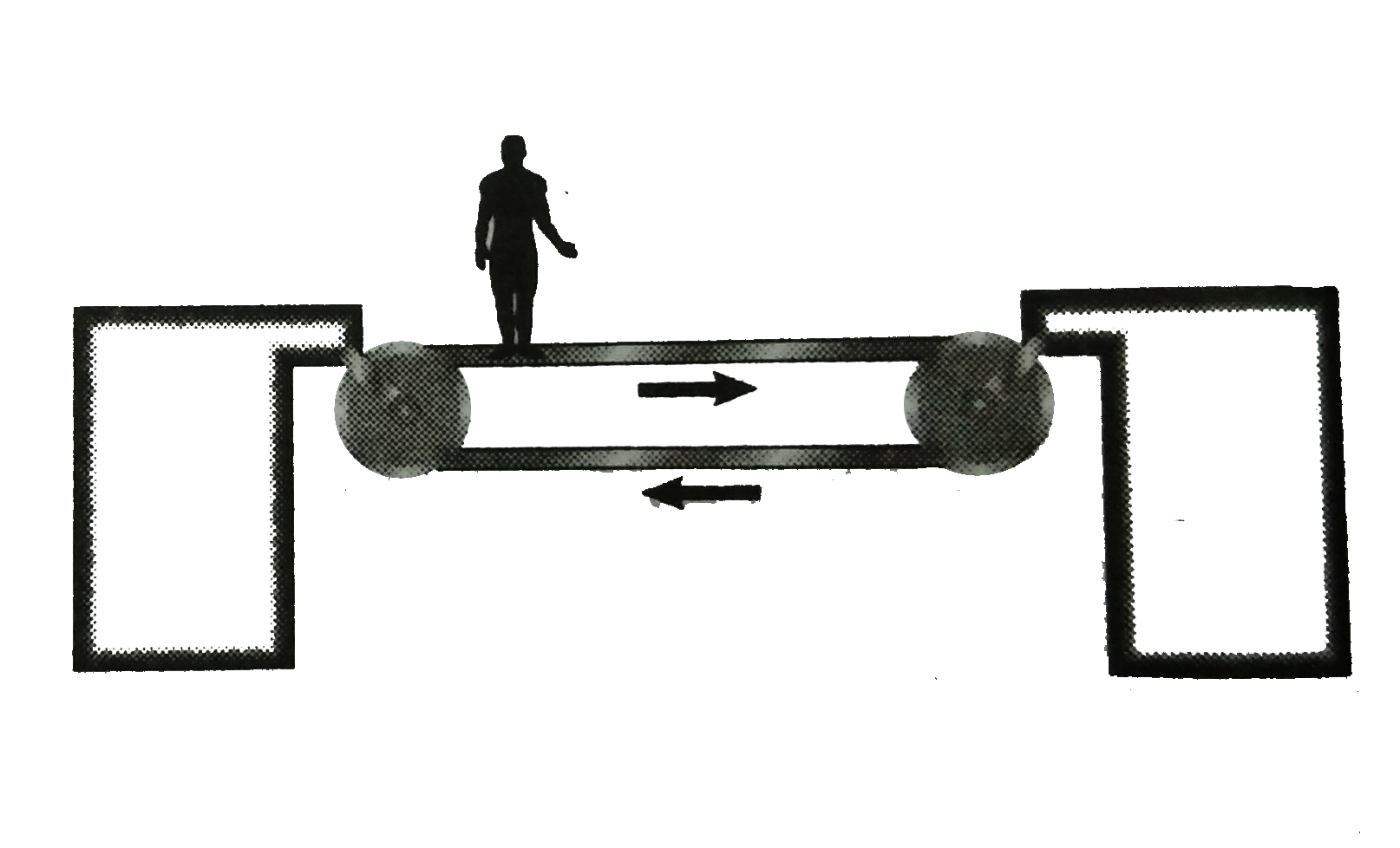 05:56View Solution
05:56View SolutionA stone of mass m tied to the end of a string revolves in a vertical circle of radius R. The net forces at the lowest and highest points of the circle directed vertically downwards are: [Choose the correct alternative]

`T_(1)` and `V_(1)` denote the tension and speed at the lowest point `T_(2)` and `V_(2)` denote the corresponding values at the highest points.01:13View SolutionA helicopter of mass 2000 kg rises with a vertical acceleration of `15ms^-2`. The total mass of the crew and passengers is 500 kg. Give the magnitude and direction of the (g`=10ms^-2`)
(a) Force on the floor of the helicopter by the crew and passengers.
(b) action of the rotor of the helicopter on the surrounding air.
(c ) force on the helicopter dur to the surrounding air.05:00View SolutionA stream of water flowing horizontally with a speed of `15 ms^(-1)` pushes out of a tube of cross sectional area `10^(-2)m^(2)` and hits a vertical wall near by what is the force exerted on the wall by the impact of water assuming.that it does not rebound? (Density of water `=1000 kg m^(3)`)
05:21View SolutionTen one-rupee coins are put on top of each other on a table. Each coin has a mass m . Give the magnitude and direction of
(a) the force on the `7^(th)` coin (counted from the bottom due to all the coins on its top.
(b) the force on the `7^(th)` coin by the eight coin.
(c) the reaction of the `6^(th)` coin one the `7^(th)` coin.06:22View SolutionAn aircraft executes a horizontal loop at a speed of `720 km h^(-1)`, with its wings banked at `15^(@)` What is the radius of the loop ?
02:14View SolutionA train rounds an unbanked circular bend of radius 30 m at a speed of `54 km//h`. The mass of the train is `10^(6)` kg. What provides the centripetal force required for this purpose - The engine or the rails ? What is the angle of banking required to prevent wearing out the rails ?
01:55View SolutionA block of mass 25 kg is raised by a 50kg man in two different ways as shown in fig. what is the action on the floor by the man in the two cases? If the floor yields to a normal force of `700N`, which mode should the man adopt to lift the block without the floor yielding?
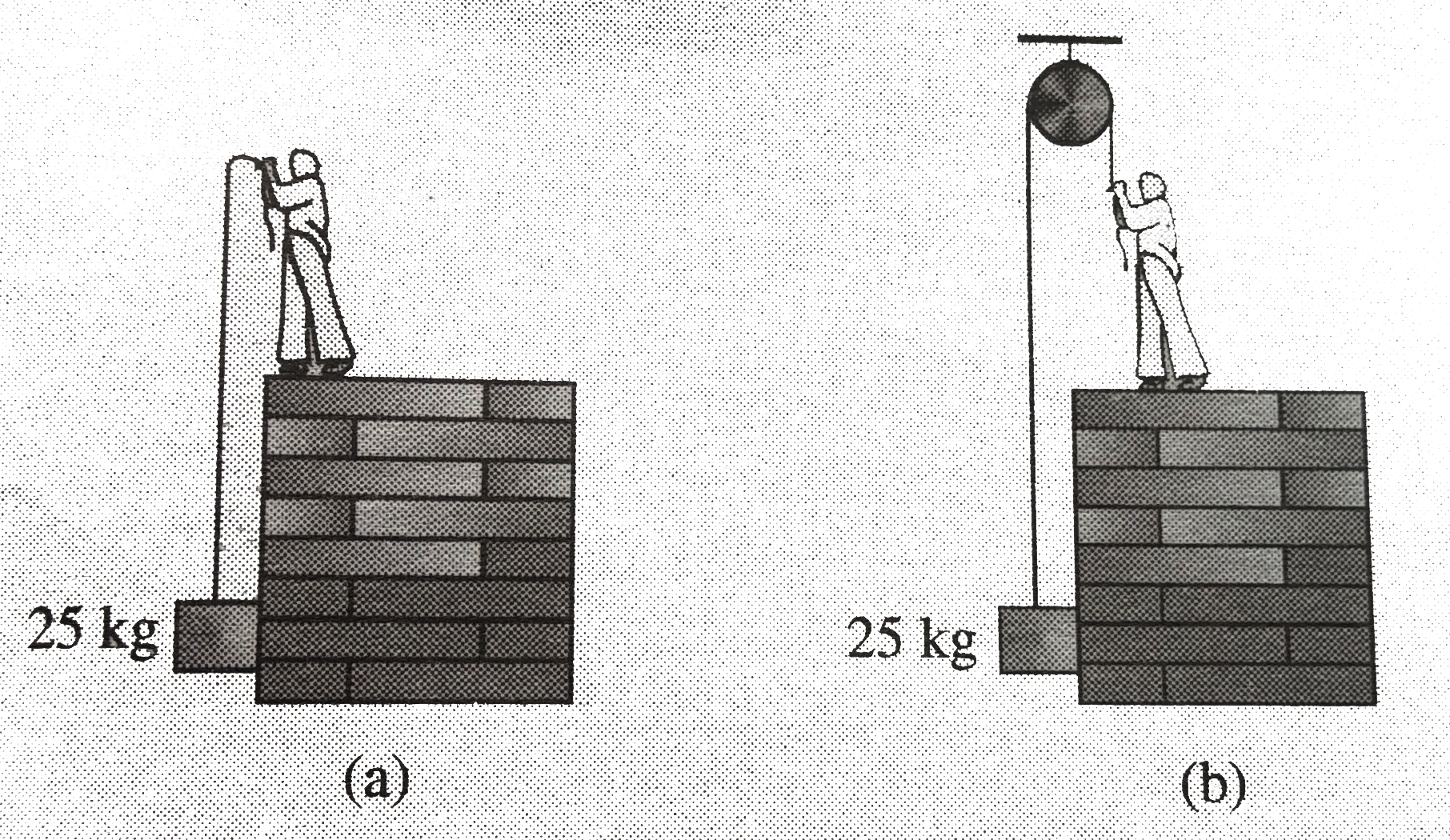 07:35View Solution
07:35View SolutionA monkey of mass 40 kg climbs on a rope which can withstand a maximum tension of 600 N In which of the following cases will the rope break : The monkey
(a) climbs up with an acceleration of `6 ms^(-2)`
(b) climbs down with an acceleration of `4 ms^(-2)`
(c) climbs up with a uniform speed of `5 ms^(-1)`
(d) falls down the rope nearly freely under gravity ? (Ignore the mass of the rope.)04:25View SolutionTwo bodies A and B of mass 5 kg and 10 kg contact with each other rest on a table against a rigid The coefficient of friction between the bodies and the table is 0.15 A force of 200 N is applied horizontal on A What are (a) the reaction of thee wall (b) the the action , reaction forces between A & B ? What happens when the wall is removed ? Does the answer to (b) Change, when the bodies are in motion ? Ignore difference between `mu_(s)` and `mu_(k)`
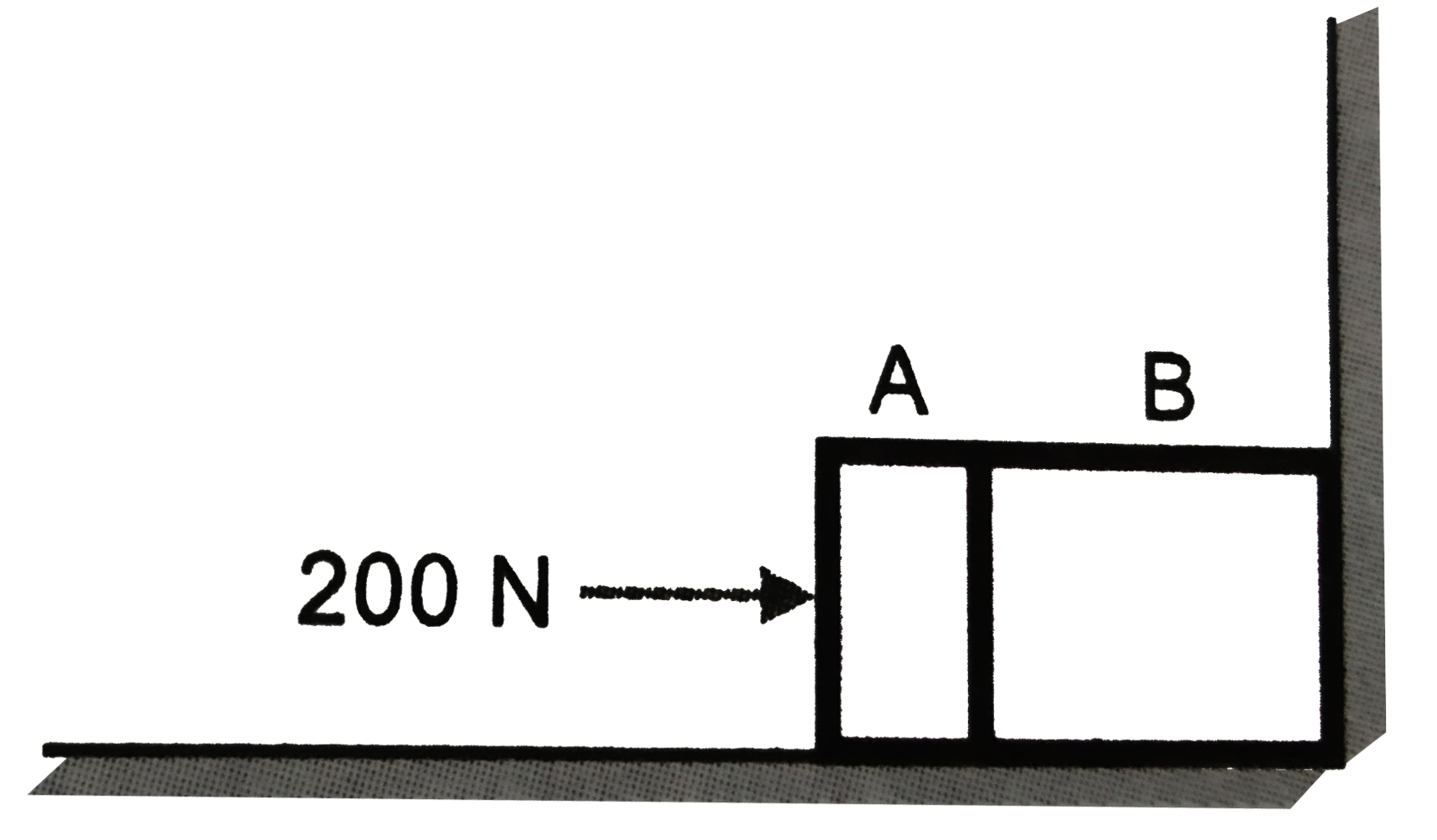 . 13:53View Solution
. 13:53View SolutionA block of mass 15 kg is placed on a long trolley . The coefficient of friction between the block and trolley is 0.18 The trolley accelerates from rest at ` 0.5 m//s^(2) ` for 20 seconds and then moves with a uniform velocity Discuss the motion of the block as viewed by (i) a stationary observer on the ground, (ii) an observer moving with the trolley.
08:55View SolutionThe rear side of a truck is open and a box of 40 kg mass is placed 5 m from the open end The coefficient of friction between the box and the surface below it is 0.15 On a straight road the truck starts from rest and accelerates with `2 m//s^(2)`. At what distance from the starting point does the box fall off the truck ? Ignore the size of the box.
03:50View SolutionA long plying record revolves with a speed of `33 (1)/(3) "rev min"^(-1)`, and has a radius of 15 cm. Two coins are placed at 4 cm and 14 cm away from the centre of the record. If the coefficient of friction between the coins and the record is 0.15, which of the two coins will revolve with the record ? Take `g = 9.8 ms^(-2)`.
04:30View SolutionYou may have seen in a circus a motorcyclist driving in vertical loops inside a death well (a hollow spherical chamber with holes, so the spectators can watch from outside). Explain clearly why the motorcyclist does not drop down when he is at the uppermost point of death well with no support from below. What is the minimum speed required at the uppermost position to perform a vertical loop if the radius of the chamber is 25 m ?
02:03View SolutionA `70kg` man stands in contact against the inner wall of a hollow cylindrical drum of radius `3m` rotating about its vertical axis. The coefficient of friction between the wall and his clothing is `0.15`. What is the minimum rotational speed of the cylinder to enable the man to remain stuck to the wall (without falling) when the floor is suddenly removed?
02:39View SolutionA thin circular wire of radius `R` rotates about its vertical diameter with an angular frequency `omega`. Show that a small bead on the wire remain at its lowermost point for `omegalesqrt(g//R)` . What is angle made by the radius vector joining the center to the bead with the vertical downward direction for `omega=sqrt(2g//R)` ? Neglect friction.
03:42View Solution
EXERCISE questions and complete solutions for chapter LAWS OF MOTION of NCERT PHYSICS(HINGLISH) of Class 11
